The F-35 program is attempting to fight its way back from severe cost and schedule problems that put the joint service project under intense scrutiny in recent years. Since the program’s 2010 restructure—to allow more time to accomplish test, development, and production milestones—it is now ahead of the revised schedule in most categories, catching up fast in others.
Not all the news is good, however. Costs have continued to rise, partly because DOD slowed the production rate to produce only about 30 aircraft a year.
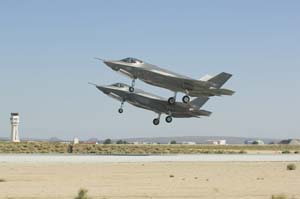
| ||
|
AF-2 and AF-4 F-35s perform a touch and go at Edwards AFB, Calif. (Lockheed Martin photo) |
According to Lockheed Martin and Pentagon program officials, F-35 flights and cumulative test point goals in 2011 exceeded the revised schedule by seven percent. Static structural testing was completed, and the short takeoff and vertical landing variant, the F-35B, finished all at-sea test objectives during a deployment to the USS Wasp amphibious assault ship. Six aircraft have been delivered to Eglin AFB, Fla., where they are conducting preliminary flying ahead of the launch of operational pilot training later this year.
Flight tests and test points accomplished in 2012 so far are surpassing the levels of 2011, tracking to 35 percent ahead of the revised schedule. Flying with external weapons has commenced, as has nighttime aerial refueling.
The F-35 is not only a joint program but an international effort as well. Besides the US, Australia, Canada, Denmark, Italy, the Netherlands, Norway, Turkey, and the UK are partners. While some of the participating nations have delayed or reduced the number of their F-35 buys, none have left the venture, and all have voiced continuing support for it, despite its development issues. Norway actually raised its order. Israel and Japan have ordered the F-35, and it’s considered a leading competitor in South Korea’s and Singapore’s upcoming fighter contests. Spain is considering a buy as well.
Based both on financial considerations and renewed confidence, Britain, which had switched from buying all F-35B STOVL variants to F-35C carrier models, has reversed course again and is back to buying STOVLs only.
Nevertheless, significant problems persist. The unique helmet worn by F-35 pilots continues to have problems with jitter, latency, and night vision. The arresting hook assembly on the F-35C carrier version had to be redesigned because it wasn’t properly catching the arresting wire. Software, the bane of most modern weapon systems, is a continuing frustration in the code-heavy F-35.
Max Speed, Hard Turns
Vice Adm. David J. Venlet, the Pentagon’s program executive officer for the F-35, told a Senate panel in May that overall, he has “confidence in the resilience of the plan” to get the F-35 past its teething problems and into service with the Air Force, Marine Corps, and Navy. “My observations and assessments over the past year,” Venlet told the Senate airland subcommittee in a budget hearing, “give me reason to believe the basic aircraft and engine designs are sound and will deliver.”
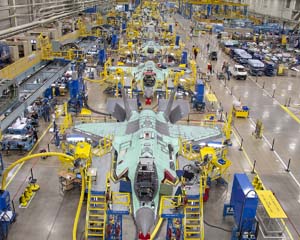
| ||
|
F-35s on the production line at Lockheed Martin’s facility in Fort Worth, Tex. |
Venlet reported “very good engine and airframe contractor responsiveness and progress” during the previous year. The tests on Wasp “exceeded plans and expectations,” he said, adding that the F-35 has now flown “to its maximum speed and hardest turn limits.” Carrier pilots, he said, are “highly complimentary” of their version’s handling characteristics in test flights at NAS Patuxent River, Md.
Software and flight tests will continue to be the focus of the program in the coming year, Venlet said, but he noted that he has “a solid program baseline” and all the necessary tools and resources to execute the program.
Concurrency—producing aircraft meant for operations while flight tests are under way, requiring rework when problems are discovered in tests—is a transient issue, Venlet said, and “will lessen over time.” The two years of extra time and additional funding built into the revised schedule was necessary, he said; however, he doesn’t think further extensions will be needed.
Neither did Gen. Norton A. Schwartz, then Air Force Chief of Staff. Asked in June if he thinks the F-35 program has had enough time to address concurrency issues, Schwartz answered, “Yes, for the A model,” the conventional takeoff and landing version to be used by USAF.
“There’s always going to be some retrofit,” Schwartz added. He pointed out this would be true of any combat aircraft. Schwartz acknowledged the issues with the STOVL and carrier models, but said the F-35A is generally meeting the Air Force’s expectations for this stage of the program. The launch of local area operations at Eglin shows the program’s progress, he said, and “we have a good sense of how it’s going.”
In his confirmation hearing to be Schwartz’s successor, Gen. Mark A. Welsh III said the head of Air Combat Command will decide later this year what criteria will constitute initial operational capability with the F-35 for the Air Force. The IOC declaration is an indication that a new asset is ready to go to war.
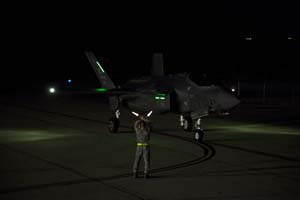 | ||
|
A crew chief marshals an F-35 after its first night flight on Jan. 18, 2012, at Edwards. (Lockheed Martin photo) |
Venlet said one element of the declaration will be completion of an initial operational test now under way, adding he’ll submit a test and evaluation master plan to Frank Kendall, undersecretary of defense for acquisition, logistics, and technology, sometime this fall.
The last two F-35 production lot contracts were of a fixed-price type, Venlet told the subcommittee, and under the sixth and seventh lot agreements, the Pentagon will be able to “control production quantity based on the performance of the development program.” The arrangement signaled DOD is headed toward a “buy to budget” approach similar to that taken on the F-22.
There are three major blocks of software associated with the F-35. The Block 2 software, flying now, allows for safe operation of the jet to the edges of the test envelope. The Block 2A software will include basic weapons capability—what Venlet called “initial warfighting” capacity. The full-up software is called Block 3 and will include “full capability” of weapons and electronic warfare, he said. Block 3 “will finish development testing in 2016 and be released to the fleet in 2017.” A Block 4 version, which will include both software and hardware changes to improve the aircraft’s performance, will constitute the first major upgrade for the F-35. The content of that upgrade is classified, but will likely include increased internal carriage of AIM-120 AMRAAM radar guided missiles, among other changes.
Venlet told the airland panel that experts from Air Force Materiel Command and Naval Air Systems Command have “looked me in the eye and confirmed for me they believe we have what it takes in time and money” to adapt to any new discoveries in flight test without derailing the program.
“Every issue that we have in view today is very much in the category of normal development for a fighter tactical aircraft,” Venlet said in testimony. “Good old-fashioned engineering is going to take care of every one of those.”
The Government Accountability Office, long an F-35 cost and schedule skeptic, said in a June report that F-35 cost has risen 42 percent between the original 2007 program baseline through the 2010 restructure, and unit costs have doubled. The Defense Department, the GAO said, “has for three straight years reduced near-term procurement quantities, deferring aircraft and costs to future years. Since 2002, the total quantity through 2017 has been reduced by three-fourths, from 1,591 to 365.” The GAO chalked up “most of the instability” in the project to “highly concurrent development, testing, and production activities.”
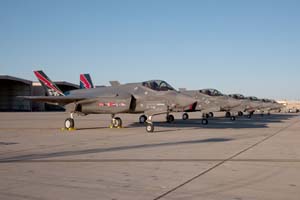
| ||
|
Six F-35s line up at Edwards. All were undergoing flight test at the base in May 2011. (Lockheed Martin photo) |
To get the cost of the F-35 down, Shay D. Assad, director of Pentagon “should cost” activities, said last year that his office was looking at whether it would be more efficient to build the F-35 in single-variant lots. The production line was structured to accommodate whichever variant came along next, but Assad thought there might be efficiencies in lumping variants together to reduce the learning curve.
That concept is not being pursued, according to Lockheed Martin vice president for aeronautics Larry A. Lawson.
“If we gap the line too long between the variants, it’s like starting over,” Lawson said in a June interview. The learning curve is hurt by such an approach, but “if we space [the variants] closely, we actually don’t see any setback on the learning curve,” he asserted.
Lawson said the way the F-35 acquisition strategy was conceived—well before his time on the program—was “genius” in that “we don’t build enough of any of the variants to have a long run in any of those.” Out of 30 aircraft in Lot 5, for example, only five are F-35B STOVLs. “You can imagine,” he said, “if you had to build a production line to build three airplanes in one year, how inefficient that would be.”
Fundamentally, he said, “using one infrastructure, one assembly line, is really an incredibly efficient way, in terms of affordability, to build at these very low rates.”
No “Aha!” Moment
However, he said that while there is a lot of focus on the factory and assembly, the bulk of F-35 costs—70 percent, he said—”is in the supply base.” There is “a unique supply base to go with each of the variants,” and planning lots efficiently means managing the vendors closely.
The STOVL, which was placed on “probation” by then-Defense Secretary Robert M. Gates due to engine and other difficulties, was taken off probation a year early by his successor, Leon E. Panetta, citing rapid progress in correcting the deficiencies. Although there’s no talk of it now, Lawson said there wouldn’t be any monetary advantage this late in the game to terminating the F-35B version.
The F-35 program endured a 10-week machinist strike in May and June, but production only slowed by half, Lawson said. Engineers, supervisors, and salaried employees were brought in from all around the company and the test flight facilities to keep things moving. Although the slowdown “gave us a chance to get some hands-on insight” into how the production line is configured, “we didn’t find a significant, ‘aha!’ ” area for change. Management found potential improvements, but nothing of a grand cost-saving nature. The strike ended at the end of June, and Lawson expected the line would be back up to speed in about a week.
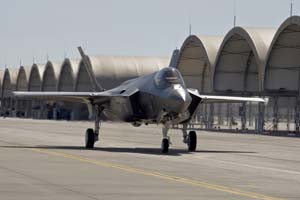
| ||
|
An F-35 at Eglin AFB, Fla., taxis out for an orientation flight. The preliminary flying at Eglin is an indicator of the program’s progress. (Lockheed Martin photo) |
The three services that operate fixed wing fighters will buy 2,457 F-35s by 2037. And while the price tag to acquire and operate those aircraft over the next 25 years is eye-watering, never before has DOD simultaneously bought aircraft and a supply, repair, and training system, with a large number of international partners, Lawson said. Moreover, he said, the F-35’s cost includes things such as an electro-optical system, advanced radar, and electronic warfare systems as part of the aircraft, but these are counted as “sold separately” on other aircraft, so making an apples-to-apples cost comparison is difficult.
Using the government’s own models, he said Lockheed Martin estimates the F-35 will be “about seven percent more expensive to operate than an F-16.” That shouldn’t be surprising, he said; the F-35 is larger and “we know we burn more fuel” with the F135 engine. That cost also “doesn’t reflect the cost of a targeting pod, … a jammer, or any other number of capabilities that are manifest in an F-35 that are not inherent on an F-16.” The fact that there is so much “more content” in an F-35 than an F-16 or F-18 creates “confusion” over comparative cost, Lawson said.
Lawson said that as new foreign military sales customers are added—and potentially demand some program manufacturing work in consideration—it doesn’t upset the F-35’s carefully laid out scheme of supply. Typically, it reduces cost to bring on a new user, he said. Whether a partner country or FMS customer, “you have to make an investment.” Full partners have invested in development; latecomers at least tool up to make parts, or perform final assembly and checkout, known as FACO. Italy has a FACO for its own F-35s, and Japan will likely have one as well.
“They’ll certainly meet their own needs, and then we’ll work with them in terms of whether there is additional interest in growing their industrial participation against a demand that may … exist at that point in time.” Taken in the aggregate, Lawson said, every F-35 sold overseas is “worth about $10 million an aircraft” in terms of reduced unit cost. When foreign countries buy the F-35, it “brings down the price for everyone.”
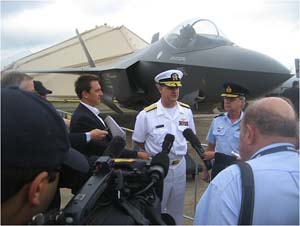
| ||
|
Vice Adm. David Venlet, DOD’s program executive officer for the F-35, speaks to media representatives. Venlet has expressed confidence that the fighter will deliver as promised. (Lockheed Martin photo) |
Lawson said Lockheed was about three months behind schedule on F-35 software early in the year and acknowledged the government “had some independent assessments that indicated that there was more schedule risk than that.” However, he asserted the program has “recovered against even the three months, as much as half of that. So we’re making good progress.” Based on his conversations with Pentagon managers, he said, “I think their confidence level is improving, in terms of where we are … and the flight [tests] continue to demonstrate that the software for flying is performing very well.”
A number of fixes are being considered for the F-35 helmet. A new short-range night vision camera will be installed, Lawson said. The existing one was “the very best camera that was available at the time the helmet was designed and built,” but the improved version should eliminate some of the concerns. The program office and Lockheed are discussing whether to retrofit existing helmets or build new ones.
Software fixes may resolve problems with jitter, in which data displays on the inside of the faceplate are not as rock-solid as pilots would like. There’s also some lag in displaying night imagery from cameras all around the aircraft, as the pilot’s head traverses the field of view of one camera to another. That latency will require another software fix.
“We’ve had over 2,000 flights” on the F-35, “and every one of those flights has been with this helmet.” There’s no concern that it’s a safety issue, he asserted.
Nine Milestones
The tailhook for the carrier version has been redesigned and data is being acquired about necessary loads. Once the data is crunched, and the new hook design is finalized, “we don’t have any more issues,” Lawson declared.
Not quite, but Lawson said other gripes about the airplane are all “nominal [issues] … within what you would expect to see during development,” a quote very similar to some made by Venlet in budget testimony.
The fact that the flight-test program is proceeding ahead of schedule for the second year in a row is a good sign that other problems are small and well on their way to being corrected, Lawson said. By the end of 2012, “45 percent of the flight science testing will be complete on the A variant. … That’s a good indicator of progress.”
In 2012, there will be nine major milestones for the F-35, according to Stephen O’Bryan, Lockheed Martin VP for F-35 business development. These are flight testing the Block 2A software; completion of the A model’s first “life” of durability testing; modification and testing of the new tailhook; the first weapons drops; high angle of attack testing; the commencement of training at Eglin; first deliveries of F-35As to Air Combat Command; standup of Navy and Marine Corps squadrons at Eglin; and first deliveries to international customers Britain and the Netherlands.
An operational utility evaluation on the A model got under way in July, and Lawson said it should be complete by the end of the year. Assuming it is successful, operational flight training should start soon afterward.
While the A model has completed its first fatigue life, both the B and C models should finish their “first life” in 2013, Lawson reported. A “life” is equivalent to 8,000 hours, but the static models will be tested to multiple lifetimes to give engineers a heads-up as to where to look for structural wear in the distant future.
Lawson said the benefits of having a common aircraft for the armed services accrue from having a busy production line and diminish when the line is moving slowly.
The production rate is “really the most powerful thing you can do to reduce cost,” Lawson asserted. “The good news,” he said, is that government cost models “show we’re moving to an affordable airplane. But the point of lowest cost is achieved at maximum rate.”
Lawson said the Air Force has kept its word about not meddling with requirements on the F-35, which on other programs has led to requirements “creep” that has added cost and put timetables in jeopardy.
“There’s certainly a lot of attention to what the Block 4 configuration is,” he noted. “The government leads those [discussions].” He said what’s considered for the improvement program follows “a threat-driven approach.” There are “a number of modifications that we can make to the airplane to address future threats,” he added, but because the mold line must remain more or less unchanged, these changes have to do with internal equipment.
There are some systems “where you may want to add an additional card to an existing suite,” he observed, and the F-35 will likely be fitted for new weapons, as they come along, and other means to defeat the anti-access capabilities of adversaries.
He likened the F-35 to the F-15, on which he worked early in his career. The F-15 was declared operational in 1975, fully 37 years ago, “and as I reflect on [the F-35], I’m confident this airplane is going to be around for four-plus decades,” Lawson said.